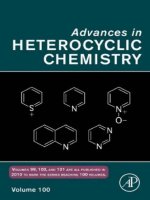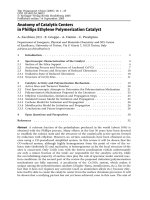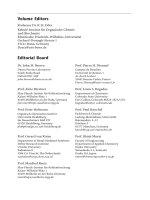(Topics in heterocyclic chemistry 6) masatomi ohno, shoji eguchi (auth ), shoji eguchi (eds ) bioactive heterocycles i springer verlag berlin heidelberg (2006)
Bạn đang xem bản rút gọn của tài liệu. Xem và tải ngay bản đầy đủ của tài liệu tại đây (8.57 MB, 231 trang )
6
Topics in Heterocyclic Chemistry
Series Editor: R. R. Gupta
Editorial Board:
D. Enders · S. V. Ley · G. Mehta · A. I. Meyers
K. C. Nicolaou · R. Noyori · L. E. Overman · A. Padwa
Topics in Heterocyclic Chemistry
Series Editor: R. R. Gupta
Recently Published and Forthcoming Volumes
Bioactive Heterocycles I
Volume Editor: S. Eguchi
Volume 6, 2006
Marine Natural Products
Volume Editor: H. Kiyota
Volume 5, 2006
QSAR and Molecular Modeling Studies
in Heterocyclic Drugs II
Volume Editor: S. P. Gupta
Volume 4, 2006
QSAR and Molecular Modeling Studies
in Heterocyclic Drugs I
Volume Editor: S. P. Gupta
Volume 3, 2006
Heterocyclic Antitumor Antibiotics
Volume Editor: M. Lee
Volume 2, 2006
Microwave-Assisted Synthesis of Heterocycles
Volume Editors: E. Van der Eycken, C. O. Kappe
Volume 1, 2006
Bioactive Heterocycles I
Volume Editor: Shoji Eguchi
With contributions by
S. Eguchi · M. Kita · H. Kiyota · H. Nishino
M. Ohno · M. Somei · D. Uemura
123
The series Topics in Heterocyclic Chemistry presents critical reviews on “Heterocyclic Compounds”
within topic-related volumes dealing with all aspects such as synthesis, reaction mechanisms, structure
complexity, properties, reactivity, stability, fundamental and theoretical studies, biology, biomedical
studies, pharmacological aspects, applications in material sciences, etc. Metabolism will be also included which will provide information useful in designing pharmacologically active agents. Pathways
involving destruction of heterocyclic rings will also be dealt with so that synthesis of specifically
functionalized non-heterocyclic molecules can be designed.
The overall scope is to cover topics dealing with most of the areas of current trends in heterocyclic
chemistry which will suit to a larger heterocyclic community.
As a rule contributions are specially commissioned. The editors and publishers will, however, always
be pleased to receive suggestions and supplementary information. Papers are accepted for Topics in
Heterocyclic Chemistry in English.
In references Topics in Heterocyclic Chemistry is abbreviated Top Heterocycl Chem and is cited as
a journal.
Springer WWW home page: springer.com
Visit the THC content at springerlink.com
Library of Congress Control Number: 2006926509
ISSN 1861-9282
ISBN-10 3-540-33350-9 Springer Berlin Heidelberg New York
ISBN-13 978-3-540-33350-0 Springer Berlin Heidelberg New York
DOI 10.1007/11514725
This work is subject to copyright. All rights are reserved, whether the whole or part of the material
is concerned, specifically the rights of translation, reprinting, reuse of illustrations, recitation, broadcasting, reproduction on microfilm or in any other way, and storage in data banks. Duplication of
this publication or parts thereof is permitted only under the provisions of the German Copyright Law
of September 9, 1965, in its current version, and permission for use must always be obtained from
Springer. Violations are liable for prosecution under the German Copyright Law.
Springer is a part of Springer Science+Business Media
springer.com
c Springer-Verlag Berlin Heidelberg 2006
Printed in Germany
The use of registered names, trademarks, etc. in this publication does not imply, even in the absence
of a specific statement, that such names are exempt from the relevant protective laws and regulations
and therefore free for general use.
Cover design: Design & Production GmbH, Heidelberg
Typesetting and Production: LE-TEX Jelonek, Schmidt & Vöckler GbR, Leipzig
Printed on acid-free paper 02/3100 YL – 5 4 3 2 1 0
Series Editor
Prof. R. R. Gupta
10A, Vasundhara Colony
Lane No. 1, Tonk Road
Jaipur-302 018, India
Volume Editor
Prof. Shoji Eguchi
Department of Molecular Design and Engineering
Graduate School of Engineering
Nagoya University
Furo-cho, Chikusa-ku
Nagoya 464-8603, Japan
Editorial Board
Prof. D. Enders
Prof. A.I. Meyers
RWTH Aachen
Institut für Organische Chemie
D-52074, Aachen, Germany
Emeritus Distinguished Professor of
Department of Chemistry
Colorado State University
Fort Collins, CO 80523-1872, USA
Prof. Steven V. Ley FRS
BP 1702 Professor
and Head of Organic Chemistry
University of Cambridge
Department of Chemistry
Lensfield Road
Cambridge, CB2 1EW, UK
Prof. G. Mehta FRS
Director
Department of Organic Chemistry
Indian Institute of Science
Bangalore- 560 012, India
Prof. K.C. Nicolaou
Chairman
Department of Chemistry
The Scripps Research Institute
10550 N. Torrey Pines Rd.
La Jolla, California 92037, USA
and
Professor of Chemistry
Department of Chemistry and Biochemistry
University of California
San Diego, 9500 Gilman Drive
La Jolla, California 92093, USA
VI
Editorial Board
Prof. Ryoji Noyori NL
Prof. Larry E. Overman
President
RIKEN (The Institute of Physical and Chemical Research)
2-1 Hirosawa, Wako
Saitama 351-0198, Japan
and
University Professor
Department of Chemistry
Nagoya University
Chikusa, Nagoya 464-8602, Japan
Distinguished Professor
Department of Chemistry
516 Rowland Hall
University of California, Irvine
Irvine, CA 92697-2025
Prof. Albert Padwa
William P. Timmie Professor of Chemistry
Department of Chemistry
Emory University
Atlanta, GA 30322, USA
Topics in Heterocyclic Chemistry
Also Available Electronically
For all customers who have a standing order to Topics in Heterocyclic Chemistry, we offer the electronic version via SpringerLink free of charge. Please
contact your librarian who can receive a password or free access to the full
articles by registering at:
springerlink.com
If you do not have a subscription, you can still view the tables of contents of the
volumes and the abstract of each article by going to the SpringerLink Homepage, clicking on “Browse by Online Libraries”, then “Chemical Sciences”, and
finally choose Topics in Heterocyclic Chemistry.
You will find information about the
–
–
–
–
Editorial Board
Aims and Scope
Instructions for Authors
Sample Contribution
at springer.com using the search function.
Preface to the Series
Topics in Heterocyclic Chemistry presents critical accounts of heterocyclic compounds (cyclic compounds containing at least one heteroatom other than carbon in the ring) ranging from three members to supramolecules. More than
50% of billions of compounds listed in Chemical Abstracts are heterocyclic compounds. The branch of chemistry dealing with these heterocyclic compounds
is called heterocyclic chemistry, which is the largest branch of chemistry and
as such the chemical literature appearing every year as research papers and
review articles is vast and can not be covered in a single volume.
This series in heterocyclic chemistry is being introduced to collectively make
available critically and comprehensively reviewed literature scattered in various journals as papers and review articles. All sorts of heterocyclic compounds
originating from synthesis, natural products, marine products, insects, etc. will
be covered. Several heterocyclic compounds play a significant role in maintaining life. Blood constituent hemoglobin and purines as well as pyrimidines,
the constituents of nucleic acid (DNA and RNA) are also heterocyclic compounds. Several amino acids, carbohydrates, vitamins, alkaloids, antibiotics,
etc. are also heterocyclic compounds that are essential for life. Heterocyclic
compounds are widely used in clinical practice as drugs, but all applications of
heterocyclic medicines can not be discussed in detail. In addition to such applications, heterocyclic compounds also find several applications in the plastics
industry, in photography as sensitizers and developers, and in dye industry as
dyes, etc.
Each volume will be thematic, dealing with a specific and related subject
that will cover fundamental, basic aspects including synthesis, isolation, purification, physical and chemical properties, stability and reactivity, reactions
involving mechanisms, intra- and intermolecular transformations, intra- and
intermolecular rearrangements, applications as medicinal agents, biological
and biomedical studies, pharmacological aspects, applications in material science, and industrial and structural applications.
The synthesis of heterocyclic compounds using transition metals and using heterocyclic compounds as intermediates in the synthesis of other organic
compounds will be an additional feature of each volume. Pathways involving the
destruction of heterocyclic rings will also be dealt with so that the synthesis of
specifically functionalized non-heterocyclic molecules can be designed. Each
X
Preface to the Series
volume in this series will provide an overall picture of heterocyclic compounds
critically and comprehensively evaluated based on five to ten years of literature.
Graduates, research students and scientists in the fields of chemistry, pharmaceutical chemistry, medicinal chemistry, dyestuff chemistry, agrochemistry,
etc. in universities, industry, and research organizations will find this series
useful.
I express my sincere thanks to the Springer staff, especially to Dr. Marion
Hertel, executive editor, chemistry, and Birgit Kollmar-Thoni, desk editor,
chemistry, for their excellent collaboration during the establishment of this
series and preparation of the volumes. I also thank my colleague Dr. Mahendra
Kumar for providing valuable suggestions. I am also thankful to my wife Mrs.
Vimla Gupta for her multifaceted cooperation.
Jaipur, 31 January 2006
R.R. Gupta
Preface
In the series of Topics in Heterocyclic Chemistry, the volume of Bioactive
Heterocycles aims to present comprehensive reviews on selected topics of
synthetic as well as naturally occurring bioactive heterocycles.
The present volume comprises six chapters of the following specialized
reviews.
The first chapter, ‘Directed Synthesis of Biologically Interesting Heterocycles
with Squaric Acid Based Technology’ by Masatomi Ohno and Shoji Eguchi covers squaric acid and its derivatives as versatile synthons for target-oriented and
diversity-oriented synthesis. The introduction of designed functional groups,
followed by ring conversion induced thermally or by reactive intermediates can
construct a various bioactive heterocycles including bioactive natural products.
The second chapter ‘Manganese(III)-Based Peroxidation of Alkenes to Heterocycles’ by Hiroshi Nishino presents a very comprehensive review on novel
Mn(III)-based peroxidation chemistry, and related bioactive heterocycles based
on the works of his group. The content includes synthesis of functionalized
1,2-dioxane derivatives from various 1,3-dicarbonyl compounds including nitrogen heterocycles. The spectroscopic feature, the formation mechanism of
1,2-dioxan-3-ol ring system, chemical transformations and synthetic applications are also discussed.
The third chapter ‘A Frontier in Indole Chemistry: 1-Hydroxyindoles, 1Hydroxytryptamines, and 1-Hydroxytryptophans’ by Masanori Somei presents
a very comprehensive review on chemistry of 1-hydroxy-indoles, -tryptamines,
and -tryptophans as a frontier in indole chemistry. In fact, these new members
of indole derivatives were not much known about 30 years ago in the long
histry of indole alkaloids and related chemistry. Nowadays, these new families
of indole compounds have been demonstrated to play their important role
in life and nature by the pioneering works of Somei and his coworkers. The
interesting biological and pharmaceutical activities have been found in these
derivatives.
The fourth chapter ‘Quinazoline Alkaloids and Related Chemistry’ by Shoji
Eguchi provides a perspective review focusing on developements of the synthetic methodologies and their synthetic applications. A brief historical background, aza-Wittig methodology, microwave-assisted synthesis, solid-phase
XII
Preface
synthesis, and a variety of new synthesis of quinazoline compounds by organometallic reagents, metal-catalyzed reactions, heterocyclizations, pericyclic reactions etc are briefly reviewed. Selected topics of total synthesis of various
types of quinazoline alkaloids including substituted type like febrifugine and
heterocycle-fused type such as pyrroloquinazolines, indolopyridoquinazolines, pyrazinoquinazolines, pyrroloquinazolinoquinolines by these methodologies are discussed.
The fifth chapter ‘Bioactive Heterocyclic Alkaloids from Marine Orgin’ by
Masakin Kita and Daisuke Uemura presents a very comprehensive review on
novel heterocyclic marine alkaloids with very intriguing structures and useful
biological properties like anti-osteoprotic activity focusing on isolations, structural, synthetic, biological, and biogenetic studies mainly by Uemura group.
The contents are believed to attract much attention by organic chemists, heterocyclic chemists, synthetic chemists, and workers in medicinal, pharmaceutical
and bioscience fields.
The sixth chapter ‘Synthetic Studies on Heterocyclic Antibiotics Containing
Nitrogen Atoms’ by Hiromasa Kiyota presents a very comprehensive review on
a variety of heterocyclic antibiotics and phytotoxins. Early and recent examples
of synthetic studies of glutarimide antibiotics, antimycins, and tabtoxins and
related bioactive heterocycles based on the works of his group are retrospectively reviewed. The content is believed to attracts much interest of synthetic
chemists as well as heterocyclic chemists and researchers in life science fields.
I hope that our readers find this series to be a useful guide to modern heterocyclic chemistry. As always, I encourage both suggestions for improvements
and ideas for review topics.
Nagoya, March 2006
Shoji Eguchi
Contents
Directed Synthesis of Biologically Interesting Heterocycles
with Squaric Acid (3,4-Dihydroxy-3-cyclobutene-1,2-dione)
Based Technology
M. Ohno · S. Eguchi . . . . . . . . . . . . . . . . . . . . . . . . . . . . .
1
Manganese(III)-Based Peroxidation of Alkenes to Heterocycles
H. Nishino . . . . . . . . . . . . . . . . . . . . . . . . . . . . . . . . .
39
A Frontier in Indole Chemistry:
1-Hydroxyindoles, 1-Hydroxytryptamines, and 1-Hydroxytryptophans
M. Somei . . . . . . . . . . . . . . . . . . . . . . . . . . . . . . . . . .
77
Quinazoline Alkaloids and Related Chemistry
S. Eguchi . . . . . . . . . . . . . . . . . . . . . . . . . . . . . . . . . . 113
Bioactive Heterocyclic Alkaloids of Marine Origin
M. Kita · D. Uemura . . . . . . . . . . . . . . . . . . . . . . . . . . . . 157
Synthetic Studies
on Heterocyclic Antibiotics Containing Nitrogen Atoms
H. Kiyota . . . . . . . . . . . . . . . . . . . . . . . . . . . . . . . . . . 181
Author Index Volumes 1–6 . . . . . . . . . . . . . . . . . . . . . . . . . 215
Subject Index . . . . . . . . . . . . . . . . . . . . . . . . . . . . . . . . 219
Contents of Volume 2
Heterocyclic Antitumor Antibiotics
Volume Editor: Mosews Lee
ISBN: 3-540-30982-9
Synthesis of Biologically Active Heterocyclic Stilbene
and Chalcone Analogs of Combretastatin
T. Brown · H. Holt Jr. · M. Lee
Pyrrole Natural Products with Antitumor Properties
J. T. Gupton
Synthesis of Carbolines Possessing Antitumor Activity
B. E. Love
Diazo and Diazonium DNA Cleavage Agents:
Studies on Model Systems and Natural Product Mechanisms of Action
D. P. Arya
Novel Synthetic Antibacterial Agents
M. Daneshtalab
Overcoming Bacterial Resistance: Role of β-Lactamase Inhibitors
S. N. Maiti · R. P. Kamalesh Babu · R. Shan
Top Heterocycl Chem (2006) 6: 1–37
DOI 10.1007/7081_035
© Springer-Verlag Berlin Heidelberg 2006
Published online: 21 April 2006
Directed Synthesis of Biologically Interesting Heterocycles
with Squaric Acid (3,4-Dihydroxy-3-cyclobutene-1,2-dione)
Based Technology
Masatomi Ohno1 (✉) · Shoji Eguchi2
1 Department
of Advanced Science and Technology, Toyota Technological Institute,
2-12-1 Hisakata, Tempaku, 468-8511 Nagoya, Japan
2 Department of Molecular Design & Engineering, Graduate School of Engineering,
Nagoya University, Furo-cho, Chikusa, 464-8603 Nagoya, Japan
1
Chemistry of Squaric Acid with 3-Cyclobutene-1,2-Dione Skeleton . . . . .
2
2
Derivatization of Squaric Acid to 4-Hydroxy-2-Cyclobutenone Skeleton . .
3
3
3.1
3.2
3.3
Ring Transformation of the Derivatized Cyclobutenone
Varied Reactivity in Ring Opening and Ring Closure .
Thermal Concerted Process . . . . . . . . . . . . . . . .
Reactive Intermediate Induced Process . . . . . . . . .
.
.
.
.
5
5
9
21
4
Squaric Acid Bioisostere . . . . . . . . . . . . . . . . . . . . . . . . . . . .
27
5
Concluding Remarks . . . . . . . . . . . . . . . . . . . . . . . . . . . . . .
32
References . . . . . . . . . . . . . . . . . . . . . . . . . . . . . . . . . . . . . . .
32
.
.
.
.
.
.
.
.
.
.
.
.
.
.
.
.
.
.
.
.
.
.
.
.
.
.
.
.
.
.
.
.
.
.
.
.
.
.
.
.
Abstract A variety of methods for organic transformation starting from squaric acid
have been developed in this decade. These are based on conversion of pseudoaromatic
3,4-dihydroxy-3-cyclobutene-1,2-dione into the more reactive 4-hydroxy-2-cyclobutenone
by introduction of the required (or desired) functional groups followed by key ring transformation, the rearrangement being stimulated thermally or induced by a reactive intermediate. These strategies can construct a variety of bioactive heterocycles when functional groups contain heteroatoms or heterocycles. Interestingly, squaric acid is rendered
as an acid part, for example, of an amino acid, and this bioisostere concept is extended
to various heterocycle-containing squaramides (3,4-diamino-3-cyclobutene-1,2-dione
derivatives) as bioactive conjugate compounds. This review article covers biologically
interesting heterocyclic compounds accessible with the squaric acid based technology.
Keywords Bioisostere · Cyclobutenone · Electrocyclic reaction · Reactive intermediate ·
Squaric acid
2
M. Ohno · S. Eguchi
1
Chemistry of Squaric Acid with 3-Cyclobutene-1,2-Dione Skeleton
Squaric acid (1) is categorized as an oxocarbon having a four-membered
ring [1] (Fig. 1). Despite being a small molecule, it possesses unique 2πpseudoaromaticity [2–5], which brings high acidity (pKa1 = 0.52, pKa2 =
3.48) as an organic acid, and polyfunctionality, including two hydroxyl and
two carbonyl groups conjugated across a double bond. Peculiar hydrogenbonded network and chelated structures in some acid derivatives have been
occasionally discussed [6–12]. The unique structure is utilized in electronic
devices, for example, as a donor–acceptor triad called “squaraine” (2) [1, 13–
15]. The dicationic nature of the cyclobutene ring necessary for aromatic
character is combined with the donating nature of aromatic and heteroaromatic rings to produce SHG properties, for example [16]. Dimer 3 is a new
candidate designed for extension of conjugation plane [17, 18].
On the other hand, the unique structure of 1 has also been applied in organic synthesis as an attractive C4 -synthon. The relief of ring strain can serve
as a significant driving force in its ring-transformation reaction and this is in
fact accomplished by two processes. The first is conversion of the stable aromatic cyclobutenedione system to the more reactive hydroxycyclobutenone
system; where required or desired substituents can be introduced into the
ring system. The second is ring expansion from a four-membered ring to
five ∼ seven-membered rings in either concerted or stepwise manner. This
methodology has been exploited in the synthesis of various bioactive carboand heterocycles [19–23]. Another feature of using 1 to develop bioactive
compounds is based on variation of substituents on squaric acid esters and
amides, where the cyclobutenedione ring is still retained. In fact, semisquaric
acid (4), which is known as moniliformin, is a primitive derivative with biological activity (mycotoxin) [24]. According to the concept, for 1 to play
Fig. 1 Squaric acid and its derivatives [1–18]
Squaric Acid Based Technology
3
a role of bioisostere (e.g., semisquaric acid is considered to have similarity to
pyruvic acid in structure), research has pursued the possibility of 1 as a replaceable moiety for an acid part of natural products such as amino acids
and nucleic acids, and for a certain part of pharmacoactive compounds (see
later). As a synthetic tool, the use of 1 has recently been demonstrated in
asymmetric reduction adopting the cyclobutenedione as a ligand with a chiral
center [25, 26].
2
Derivatization of Squaric Acid to 4-Hydroxy-2-Cyclobutenone Skeleton
Squaric acid itself is almost useless for this aim because of its intrinsic aromatic stability and difficult solubility in organic solvents. Instead, its esters 5
are the most convenient compounds from which derivatization reactions
start. While acid 1 and its esters are now commercially available, (cf. 1 is now
produced on a commercial basis by Kyowa Hakkou Kogyo Co. Japan [27]).
The esterification method for 1 is improved [28] and preparation of dimethyl
squarate 5 (R = CH3 ) is recorded in Organic Synthesis [29].
There are several approaches for derivatization of squaric acid (1). The
traditional major route relies on the nucleophilic reaction of the eligible
esters 5 with organolithium and organomagnesium reagents; their addition to 5 is known to be sufficiently selective to give 1,2-addition products 6 (4-substituted 4-hydroxy-2-cyclobutenones) from the former and
1,4-addition products 7 (3-substituted cyclobutene-1,2-diones) from the lat-
4
M. Ohno · S. Eguchi
Scheme 1 Derivatization of squaric acid: traditional nucleophilic conditions [30–33]
Scheme 2 Derivatization of squaric acid: organometallic routes via coupling reactions [34–39]
addition in allylsilanes and silyl enol ethers. TiCl4 catalyzes 1,2-addition and
ZnCl2 1,4-addition in silyl ketene acetals regardless of the substitution pattern. Only silyl enol ethers and silyl ketene acetals are reactive with diester 5
via 1,4-addition. In addition to the above carbonyl group activation, the acetal 10 is also a useful candidate for generating the electrophilic center under
these conditions. Thus, besides typical organosilanes, azide functions can be
introduced with BF3 -catalysis (vide infra).
Similar electrophilic Friedel–Crafts-like reactions allow the most reactive
dichloride 17 to furnish 1,4-diarylcyclobutenedione derivatives [44, 45]; for
example, 1,4-thieno[3,2-b]pyrrole-substituted cyclobutenedione 23 was prepared by this method and an oxygen-inserted conjugation system 24 was
attained as a photochromic devise [46] (Scheme 4).
Apart from these methods based on the squaric acid family, direct formation of cyclobutenedione rings by [4 + 2] and [2 + 2] cycloaddition reactions
is a plausible approach to variably substituted 4-hydroxy-2-cyclobutenone
systems [47–54].
Squaric Acid Based Technology
5
Scheme 3 Derivatization of squaric acid: electrophilic conditions using unsaturated
organosilanes [40–43]
Scheme 4 Derivatization of squaric acid by Friedel–Crafts-like reaction: an example [46]
3
Ring Transformation of the Derivatized Cyclobutenone
3.1
Varied Reactivity in Ring Opening and Ring Closure
The intrinsic reactivity of small rings is ascribable to ring strain relief
in nature, and in squaric acid chemistry it is accomplished by conversion
of rather stable cyclobutene-1,2-dione to the more reactive 4-hydroxy-2cyclobutenone [55, 56] as described in the previous section. At the same
time, this conversion step fulfills the regiospecific introduction of substituents
required for the targeted heterocyclic structure. Thereby, the set-up fourmembered ring is now subjected to directed synthesis through variable ring
transformation reactions.
These involve tandem ring opening and ring closure steps, which are concerted or non-concerted. The typical concerted process is 4π-electrocyclic
6
M. Ohno · S. Eguchi
ring opening of cyclobutene to 1,3-butadiene. This was discussed in terms
of torquoselectivity by Houk [57–64]. According to his theory, π-donor substituents (R = O– , OH, NH2 ) prefer outward rotation while π-acceptor substituents (R = BMe2 , CHO) should rotate inwardly on the thermal process
(Fig. 2). Recent discovery has extended this concept; a silyl substituent accelerates and promotes inward rotation despite the resulting steric congestion,
and a stannyl substituent does similarly [65, 66].
Fig. 2 Torquoselectivity in 4π electrocyclic ring opening (thermal conditions) [57–64]
4-Hydroxy-2-cyclobutenone adheres to the above prediction [55–64]. In
this case, it is important that the inwardly-directed substituent (i.e., OH is
an outward-directing group) is capable of participating within the molecule.
Moreover, a highly reactive vinylogous ketene function occurs instead of
butadiene formation to assist efficient ring-closure through intramolecular
interaction. When an unsaturated bond is located at the 4-position, the consecutive process is thermally allowed 6π-electrocyclization (Fig. 3).
Fig. 3 Sequence of 4π–6π electrocyclic ring opening and ring closure [19–23]
This strategy is very powerful and fruitful for the directed synthesis
of both carbo- and heterocycles, and successful examples have cumulatively been reported until now [19–23]. The major contribution has come
from the Moore and Liebeskind groups. Among many efforts devoted
in this area, the recent typical example [polysubstituted naphthoquinone,
Echinochrome A (30)] constitutes a characteristic feature for the method of
directed synthesis including 26 → 27 and 28 → 29 as key steps [67]. Ferrocenyl quinone and 5-O-methylembelin were also synthesized according to this
methodology [68, 69] (Scheme 5).
In the case of monosubstituted cyclobutenone 31, the adduct with
lithiovinylsuofone 32 was reported to undergo an extraordinarily facile tandem 4π–6π electrocyclic process (33 → 34) at – 78 ◦ C to give cyclohexenone
36 [70]. The photochemical process may oblige the opposite direction on a hydroxyl group to be oriented inwardly; actually cyanohydrin 37 was reported
to give butenolide 39 as a result of an intramolecular addition reaction of
(Z)-hydroxyvinylketene 38 [71] (Scheme 6).
Squaric Acid Based Technology
7
Scheme 5 Synthesis of echinochrome A: a typical example for 4π–6π electrocyclic ring
opening and ring closure [67]
Scheme 6 Tandem 4π–6π electrocyclic concerted process at low temperature [70] and
under photochemical conditions [71]
8
M. Ohno · S. Eguchi
If the substituent is allylic and hence homoconjugative, intramolecular
[2 + 2] cycloaddition is progressive to form bicyclo[3.2.0]heptenone as shown
in Fig. 4 [19–23]. This is the second pattern of the ring transformation based
on squaric acid.
Fig. 4 Intramolecular [2 + 2] cycloaddition to bicyclo[3.2.0]heptenone [21]
The third pattern was developed by Paquette, who studied the possibility
of the concerned reaction extensively and established the cascade rearrangements route [72]. The scenario of the cascade rearrangement is:
1. 1,2-Addition of a pair of alkenyl anions (either the same or different) to
a squarate ester in an anti and/or syn manner
2. Charge-driven 4π conrotatory opening to coiled 1,3,5,7-octatetraene followed by 8π recyclization for anti-adduct, and straightforward oxy-Cope
rearrangement for syn-adduct
3. Transannular Aldol condensation for the final ring closure to bicycles
The prototype as shown in Fig. 5 was extended to more sophisticated molecular design such as a polyquinane skeleton.
Fig. 5 Cascade rearrangements following twofold addition of alkenyl anions to squarate
esters [72]
On the other hand, ring strain relief is triggered by reactive intermediates,
and as a matter of fact, this is the alternative option. The reactive intermediates are carbocation, carbon radical and carbene, and their hetero-analogs.
Once generated at the position adjacent to C-4, they mediate sequential ring
expansion to a five-membered ring [23]. The similar story may be depicted by
metal catalyses [73, 74].
Squaric Acid Based Technology
9
Fig. 6 Ring transformation induced by reactive intermediates [23]
The above ring transformation strategies have also been investigated by
beginning with preparation of cyclobutenedione and cyclobutenone skeletons
rather than employment of squaric acid [75–77].
3.2
Thermal Concerted Process
Thermal ring expansion of polysubstituted 4-hydroxy-2-cyclobutenones,
which can be prepared from squaric acid ester (see the previous section), has
been extensively studied and its synthetic value has now been confirmed. The
early works have been reviewed several times for the cases of cyclobutenones
that have unsaturated bonds at the 4-position, such as (cyclo)alkenyl, alkynyl,
and aromatic groups [19–23].
Especially, directed synthesis of heterocycles is feasible by placing heteroatoms such as nitrogen and oxygen at the appropriate position. When
hetero double bonds are located at the 4-position, tandem 4π–6π electrocyclic reactions (Fig. 3) can afford six-membered heterocycles. This is the
case for a C = O bond to give α-pyrone. Thus, treatment of cyclobutenedione [e.g., 5 (R = i-Pr)] at – 78 ◦ C with O-TBDMS-cyanohydrin/LiHMDS
followed by low-temperature quench and workup directly gave α-pyrone 41,
which is often found in bioactive compounds [37, 78]. A particularly interesting aspect is the ability of the intermediate 4-acylcyclobutenone 40 to
rearrange to 41 at or below room temperature as most ring expansions of 4aryl or 4-vinylcyclobutenones require heating at higher than 100 ◦ C. This is
attributed to greater polarization of the C = O bond (Scheme 7).
Scheme 7 Synthesis of α-pyrone: tandem 4π–6π electrocyclic concerted process with
a C = O function [78]
10
M. Ohno · S. Eguchi
The C = N version was realized by using azaheteroaryl substituents at
the 4-position [79]. The required cyclobutenones 43 were prepared by the
addition of the corresponding 2-lithioheteroaromatics (or Pd-catalyzed crosscoupling with 2-stannylheteroaromatics). The usual ring opening followed
by intramolecular cyclization of the C = N bond of azaheteroaromatics
onto the vinylketene end occurred faithfully to give quinolizin-4-ones 45a,
imidazo[1,2-a]pyridin-5-ones 45b, and thiazolo[3,2-a]pyridin-5-ones 45c
(Scheme 8).
Scheme 8 Synthesis of fused pyridones: tandem 4π–6π electrocyclic concerted process
with C = N functions [79]
Furan and thiophene have also been utilized in this type of transformation
as building blocks. In the same manner, prerequisite structures prepared by
cross-coupling as well as traditional carbanion addition were converted expectedly into benzo- and dibenzofurans and their thiophene analogs (i.e., 47
→ 48) [80]. Likewise, sesquiterpene furanoquinone 51 was synthesized [81],
and the total synthesis of the indolizidine alkaloid, septicine 54, was performed with the key step 52 → 53 for the pyrrole case [82] (Scheme 9).
Dihydropyridine is another building block. Construction of the pyridoacridone ring system, which is found in marine alkaloids and often exhibits
an array of biological activities (e.g., amphimedine), was accessible from condensation of 5 (R = i-Pr) with 1-BOC-2-lithio-1,4-dihydropyridine 55 (note:
the N atom has no nucleophilicity toward the ketene group that is formed
transiently upon thermolysis). Neat thermolysis of the 1,2-adduct 56 produced an oxazolone-fused dihydroquinoline 57 as a result of the expected
tandem 4π–6π electrocyclizations. The subsequent removal of the protecting
pyrrole group and oxidative aromatization, with loss of the oxazolone ring,
afforded the aimed-at heteropolycycle 58 [83] (Scheme 10).
The xanthone core is present in a large family of natural products with
broad biological activities. Highly substituted xanthone systems with linear
and angular fusion were designed along the cyclobutenedione route [84, 85].
First, the requisite benzopyrone-fused cyclobutenedione structure (such as 61)
was constructed by addition of dithiane anion 59b of salicylaldehyde 59a to
dimethyl squarate 5, followed by acid-catalyzed cyclization with elimination
of methanol. The next step of adding unsaturated organolithium (61 → 62)
Squaric Acid Based Technology
11
Scheme 9 Tandem 4π–6π electrocyclic concerted process with furan, thiophene, and pyrrole rings [80–82]
Scheme 10
ring [83]
Tandem 4π–6π electrocyclic concerted process with a dihydropyridine
occurred selectively at the carbonyl group opposite the bulky dithiane moiety. The key ring opening step (62 → 63) proceeded even at room temperature
(practically reflux was applied in THF) to give the target molecule after deprotection. Another method for obtaining angularly fused xanthones was done









